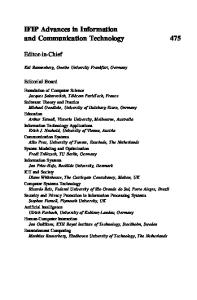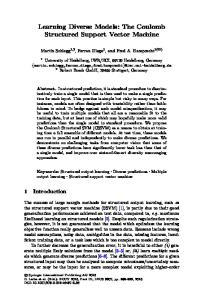Support vector machine based machine learning method for GS 8QAM constellation classification in seamless integrated fib
- PDF / 1,549,989 Bytes
- 12 Pages / 595 x 842 pts (A4) Page_size
- 44 Downloads / 352 Views
. RESEARCH PAPER .
October 2020, Vol. 63 202306:1–202306:12 https://doi.org/10.1007/s11432-019-2850-3
Support vector machine based machine learning method for GS 8QAM constellation classification in seamless integrated fiber and visible light communication system Wenqing NIU, Yinaer HA & Nan CHI* Key Laboratory for Information Science of Electromagnetic Waves (MoE), Fudan University, Shanghai 200433, China Received 5 September 2019/Revised 11 November 2019/Accepted 25 March 2020/Published online 21 September 2020
Abstract Visible light communication (VLC) network over optical fiber has become a potential candidate in ultra-high speed indoor wireless communication. To mitigate signal distortion accumulated in optical fiber and VLC channel, we present to utilize support vector machine (SVM) for constellation classification in two kinds of geometrically-shaped 8QAM (quadrature amplitude modulation) seamless integrated fiber and VLC system. We introduce 4 sub-bands to simulate multi-user. Experimental results show that system performance can be significantly improved, and transmission at −2.5 dBm input optical power under 7% forward error correction (FEC) threshold can be realized employing Circular (7, 1) geometrically-shaped 8QAM and SVM. At overall capacity of 960 Mbps, Q-factor increases by up to 11.5 dB. Keywords visible light communication, VLC, support vector machine, SVM, geometrically shaping, GS, VLC network, constellation classification Citation Niu W Q, Ha Y, Chi N. Support vector machine based machine learning method for GS 8QAM constellation classification in seamless integrated fiber and visible light communication system. Sci China Inf Sci, 2020, 63(10): 202306, https://doi.org/10.1007/s11432-019-2850-3
1
Introduction
Nowadays, there has been consistent growth in the demand of communication system with higher data rate. Visible light communication (VLC) is an emerging field of optical communication which has advantages of high capacity, environment-friendly and anti-electromagnetic interference [1]. Additionally, it can be combined with illumination, and thus VLC is an ideal candidate for high-speed indoor wireless access [2] in future 5G and even 6G systems. Extensive researches that focus on VLC network have been done [2–11]. VLC network based on power-line communications (PLC) is investigated in [4, 5], but owing to the inherent characteristic of PLC, the data rate is not satisfactory. As optical fiber can provide huge modulation bandwidth and existing optical distribution networks can be reused [3], VLC network over optical fiber is a better solution. For high capacity VLC system, the severe bandwidth limitation introduced by light-emitting diode (LED) is a major bottleneck [12]. Multi-band quadrature amplitude modulation (QAM), where the signal is divided into several sub-bands for each user in the network, could support multiple access simultaneously, and the spectrum efficiency could be improved. Figure 1 is the overview of optical fiber-based VLC network. The multi-band data for different
Data Loading...











